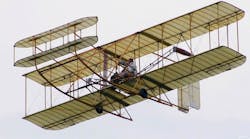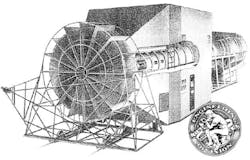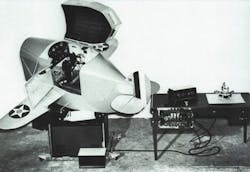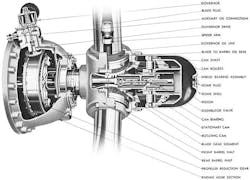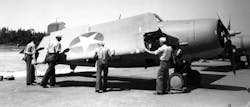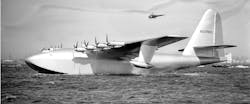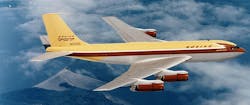Much of the early development and design of aircraft was done by mechanical engineers. There were no aeronautical engineers at the time. And even once such engineers came into vogue, the innovations in aeronautics were largely mechanical engineering in practice. Here are nine of these innovations, ones which were deemed engineering milestones by the American Society of Mechanical Engineers (ASME)
Montgomery Glider 1883
Just as it’s true you have to learn to crawl before you can walk, humans had to learn to build and fly heavier-than-air gliders before they could build a powered aircraft. The person who gets credit for creating the first successful glider is John Montgomery, who flew and controlled one of his 40-lb gliders over a 600-ft flight in 1883, 20 years before the Wright brothers would go from building gliders to the first powered aircraft.
After studying the flight of birds and wing design, he came up with several central “conclusions” that were eventually recognized by others exploring flight. These include the idea that the best shape for a wing is one “having a gradually increasing curvature from the rear to the front edge.” He also observed that when an airfoil is in motion, a wave is created with crests above the airfoil and particles approaching the airfoil rise while those leaving it descend.
Wright Flyer III 1905
The Wright Flyer III was the first airplane that demonstrated sustained, controlled flight. It was similar to their first Wright Flyer, but it had only flown a few feet above the ground and only in a straight line. The newer plane had a stronger airframe, a larger engine, specially shaped propellers, and larger control surfaces for better safety and maneuverability. Eventually, the Flyer III could fly for about 40 minutes (until it ran out of fuel), and cover 24 miles. The pilot could control direction and height, and consistently land safely.
Wright Field Wind Tunnel 1921
The Wright Field wind tunnel was built in 1921-22, when little aerodynamic theory or data existed as a basis for design. When complete, it had a 5-ft diameter test section, which let it test models with wingspans of up to 40 inches. It was also considered one the most efficient wind tunnels of its day and generated very smooth airflow. The final inspection team looking at the tunnel included Orville Wright.
The “wind” comes from, four 1,600-hp motors turning two 24-ft diameter fans with 12 blades. These let it recreate air flows from 0 to 0.23 Mach. The wind tunnel was moved in 1928-29 to Wright-Patterson Field.
From the 1920s through the 1950s, the tunnel played a role in testing and developing nearly every aircraft and associated hardware for every major U.S. Army Air Service and Air Force aircraft. The tunnel is still operational and is used as a teaching tool by the Air Force Institute of Technology.
Link C-3 Flight Trainer 1929
Ed Link earned his pilot’s wing in 1927, but it was a long, expensive, and somewhat dangerous process. Combining his flight training experience with what he had learned in his father’s piano and organ company, Link built a flight simulator that could convert trainee inputs on the stick, rudder pedals, and control column into pitch, roll and yaw. The simulator would actually move, replicating turns, pitches, banks, climbs, and dives. It was powered by pressurized air filling or not filling pneumatic bellows, an idea he “borrowed” from this father’s organ-building background.
Using the trainer for basic pilot instruction (including instrument-based flight, which was taking over) didn’t catch on until the Army bought 10,000 of them to train pilots for World War II. They saved time as training did not depend on available instructor pilots, good weather, or well-maintained aircraft. Following the war, the trainers were upgraded with electronics and other flight instruments, and in fact were used to train Apollo astronauts for moon landings as well as by space-shuttle pilots.
Hydromatic Propeller 1938
Planes in the 1930s began having controllable-pitch propellers that would let pilots increase or decrease the power generated by the prop, but not change the engine rpms by rotating the prop in the hub (changing its pitch) so it carved out larger chunks of air with its curved section. Some companies developed props with adjustable pitches, but they could only selected on the ground. Other companies’ variable-pitch props relied on springs and bladders to control the angle of the props. The goal was to have the engine always working in a sweet spot relative to rpm, but still let the pilot increase the throttle and prop pitch to get more horsepower out of the engine at the same rpm.
The hydromatic prop from Hamilton Standard used oil in a setup reminiscent of an automatic transmission to control prop pitch. Unlike previous pitch-control designs, this one could handle larger props, faster rates of pitch changes, and wider range of pitch control, making it well suited to high-output engines and rapid aircraft maneuvers. It also let the props be feathered (rotated so they didn’t spin in flight), a critical capability with a malfunctioning engine.
Precise pitch control on post-war prop-powered aircraft, including turboprop jets, let pilots synchronize and synchrophase multiple engines and thus eliminate “beats.” The prop could also be reversed, which shortens landing distances or lets the aircraft taxi backward on the ground.
Sikorsky VS-300 Helicopter 1939
The VS-300 was the first practical single-rotor helicopter. The principles used to design it, such as the torque-compensating tail rotor, were adopted by helicopter designers around the world. The first flight of the VS-300 was piloted by its designer Igor Sikorsky in Stratford, Conn. The helicopter went through several phases of development as Sikorsky struggled to give the aircraft stability, the ability to control speed, and autorotational landing, and greatly reduce vibrations. He used this design work and flight testing to develop the VS-316 (or Sikorsky R-4), the first production helicopter.
Grumman Wildcat “Sto-Wing” Mechanism 1941
During the first years of WWII, the Navy knew it had a problem with its aircraft carriers: There wasn’t enough room to hold all the planes they wanted them to carry. Some earlier designs would let planes fold their wings and reduce their footprint, but they weren’t that successful and there was no pressing need for aircraft to save space until carriers came along.
Grumman, a company that had long served the Navy, came up with a design that let the wing pivot back and fold lengthwise along the aircraft’s fuselage. It was nicknamed the “Sto wing” and was widely used on the F4F Wildcat. The first prototype was powered by hydraulic cylinders, but they were heavy, and thus were eliminated on production models of the plane. Instead, the wings were folded or unfolded manually by flight-deck crew and locked in place. When Wildcats were deployed on carriers, the total number of planes the ship could carry increased by 50%.
Howard Hughes Flying Boat 1947
The Howard Hughes Flying Boat (HK-1), better known as the Spruce Goose, was almost as odd as its designer and owner, Howard Hughes. Hughes set out to build the largest wooden aircraft and the plane with the longest wingspan in 1942. It was to be a troop and material transporter that would land and take off from the water.
Since metals such as steel and aluminum were unavailable due to the war, Hughes turned to wood. So the plane was mainly built of birch veneer cut and molded into a variety of shapes, though some spruce, poplar, maple, and balsa were also used. For power, the plane carried eight 3,000 hp Pratt & Whitney engines, which then called for the installation of 14 fuel tanks, each carrying 900 gallons of fuel. Hughes also went with a 120-V three-wire electrical system instead of the more standard 24-V. This cut the electrical system’s weight by 75%.
The aircraft ended up with wings 20 feet longer than a football field, with 4,414 ft2 of fabric-covered control surfaces (except the flaps). Hughes also had to have engineers exploring and developing large-lift capabilities and power-boost systems never seen before. The aircraft had one flight, about a mile long and no higher than 70 ft, when Hughes took it up during a taxi test. It was a sad ending for an aircraft that pioneered many new technologies.
Boeing 367-80 1954
The Dash 80 was the prototype for the Boeing 707 and the first successful jet transporter or airliner. It spawned several innovations for planes as well as aircraft tooling and manufacturing. The plane relied on turbine engines with thrust reversers and noise suppressors, and carried redundant hydraulic controls, much better cabin pressurization, honeycomb flap panels, and strong lightweight structures that controlled fatigue cracking. The engines generated few vibrations, and the flexible, sweptback wings gave a smoother ride, making the plane popular with passengers.
Boeing risked one quarter of the company to design and build the Dash 80, but the gamble paid off big time. The military bought 803 of the KC-135 Stratotankers, a military variant of the Dash 80, which was first needed to aerially refuel SAC bombers. The military still uses them. It was also the prototype for Boeing’s 707.
The company built 865 of them between 1965 and 1979, and some are still flying. Later jet airliners, including the 737, 747, 7867, and 77, as well as the DC-8, used much of the same technology and overall configuration.
